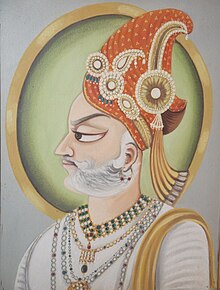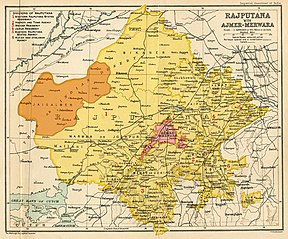Jaisalmer State
| Kingdom of Jaisalmer | |||||||||
|---|---|---|---|---|---|---|---|---|---|
| 1156–1947 | |||||||||
GOLKONDA SULTANATE | |||||||||
Jailsalmer State (orange) within Rajputana (yellow), 1909. | |||||||||
| Area | |||||||||
• 1931 | 41,600 km2 (16,100 sq mi) | ||||||||
| Population | |||||||||
• 1931 | 76,255 | ||||||||
| History | |||||||||
• Established | 1156 | ||||||||
• Independence of India | 1947 | ||||||||
| |||||||||
| Today part of | Rajasthan, India | ||||||||
| Coat of arms based on The Princely Armory. Publ. by The Office of the Superintendent of Government Printing. Calcutta. 1877 | |||||||||


The Kingdom of Jaisalmer was a
History
Early history
The royal dynasty of Jaisalmer claims to be descended from the deified hero Krishna. The Bhati rulers originally ruled parts of Afghanistan; their ancestor Rawal Gaj is believed to have founded the city of Gajni. According to James Tod, this city is present-day Ghazni in Afghanistan, while Cunningham identifies it as modern-day Rawalpindi.
His descendant Rawal Salivahan is believed to have founded the city of
Medieval history

The state of Jaisalmer had its foundations in what remains of the Empire ruled by the Bhati dynasty from the mid-12th century CE until 1947.

Modern history (Princely state of Jaisalmer)
On 11 December 1818 Jaisalmer became a British protectorate in the Rajputana Agency.[11][10]
Traditionally, in the Middle Ages, the main source of income for the kingdom was levies on
The attempts of Maharawal Jawahir Singh (1914–1949) at modernization were also not entirely successful in turning the kingdom's economy around, and the drylands of Jaisalmer remained backward compared with other regions of
After the departure of the British from India in 1947, the Maharawal signed an Instrument of Accession to the new Union of India, while retaining some internal autonomy until the 1950s.
List of rulers
Rawals
(1153–1168), official founder of the kingdom
- Rawal Shalivahan Singh II (1168–1200)
- Rawal Bijal Singh (1200–1200)
- Rawal Kailan Singh (1200–1219)
- Rawal Chachak Dev Singh (1219–1241)
- Rawal Karan Singh I (1241–1271)
- Rawal Lakhan Sen (1271–1275)
- Rawal Punpal Singh (1275–1276)
- Rawal Jait Singh I (1276–1294)
- Rawal Mulraj Singh I (1294–1295)
- Rawal Durjan Sal (Duda) (1295–1306)
- Rawal Gharsi Singh (1306–1335)
- Rawal Kehar Singh II (1335–1402)
- Rawal Lachman Singh (1402–1436)
- Rawal Bersi Singh (1436–1448)
- Rawal Chachak Dev Singh II (1448–1457)
- Rawal Devidas Singh (1457–1497)
- Rawal Jait Singh II (1497–1530)
- Rawal Karan Singh II (1530–1530)
- Rawal Lunkaran Singh (1530–1551)
- Rawal Maldev Singh (1551–1562)
- Rawal Harraj Singh (1562–1578)
- Rawal Bhim Singh (1578–1624)
- Rawal Kalyan Das (1624–1634)
- Rawal Manohar Das (1634–1648)
- Rawal Ramchandra Dev (1648–1651)
- Rawal Sabal Singh (1651–1661)
Maharawals
- Maharawal Amar Singh of Jaisalmer (1661–1702)
- Maharawal Jaswant Singh of Jaisalmer (1702–1708)
- Maharawal Budh Singh (1708–1722)
- Maharawal Akhai Singh (1722–1762)
- Maharawal Mulraj Singh II (1762–1820)
- Maharawal Gaj Singh (1820–1846)
- Maharawal Ranjit Singh (1846–1864)
- HH Maharawal Sir Bairi Sal (1864–1891)
- HH Maharawal Sir Shalivahan Singh III (1891 –1914)
- HH Maharawal Sir Jawahar Singh (1914–1949),last ruler of the state.
- HH Maharawal Girdhar Singh (1949–1950), he was instrumental in merging his former state with Rajasthan Union in the year 1949 forming Greater Rajasthan in 1950.
Titular rulers
- Maharawal Raghunath Singh (1950–1982) Government of Indiaabolished his right to Privy Purse,hereditary titles and other privileges in 1971.
- Maharawal Brijraj Singh (1982–2020)
- Maharawal Chaitanya Raj Singh (since 2020)[12]
Dewans
- List of Dewans(chief ministers)
- Mohata Nathmal (1885–1890)
- Thakur kado singh (1890-1895)
- Mehta Jagjiwan (1895–1903)
- Thakur Kushal Singh (acting) (1890?–1900)
- Rawatmal Purohit Khetrapalia (acting) (1900–1909)
- Lakshmi Das Sapat (1909–1911)
- Mohammed Niyaz Ali Kazi (1911–1912)
- Murarji Rooji (1912–1930)
- M.L. Khosala
- Pandit Jamana Lal
- Munshi Nand Kishore
- Lala Rakhpat Raj
- P.K. Shurugula
- Brij Mohan Nath Zutshi
- Anand Swaroop
- Onkar Singh
- Lakhpat Rai Sikund (1940–1942)
See also
References
- ISBN 0226742210.
- ^ "Jaisalmer". www.crwflags.com. Retrieved 16 April 2021.
- ^ Imperial Gazetteer of India, v. 24, p. 386.
- ^ "Imperial Gazetteer2 of India, Volume 14, page 2 -- Imperial Gazetteer of India -- Digital South Asia Library".
- ^ Sukhdev (2 October 2023). "Which dynasty ruled to Jaisalmer princely state?". Studentera. Retrieved 28 November 2023.
- ^ "Rajasthan or the Central and Western Rajpoot States, Volume 2, page 197-198". Higginbotham And Co. Madras. 14 August 2018.
- ^ "Imperial Gazetter of India, Volume 21, page 272 - Imperial Gazetteer of India - Digital South Asia Library". Dsal.uchicago.edu. 18 February 2013. Retrieved 22 November 2013.
- ^ "Bhatinda Government: District at A glance- Origin". Bhatinda Government. 14 August 2018. Archived from the original on 10 January 2011. Retrieved 14 August 2018.
- ^ Medieval India 1206-1526 part one, pg.17 by Satish Chandra
- ^ a b "Provincial Gazetteers Of India: Rajputana". Government of India. 14 August 2018.
- ^ Princely States of India
- ^ "Chaitanya Raj Singh becomes the 44th Maharawal of Jaisalmer". firstindia.co.in. Retrieved 11 September 2022.
External links
 Media related to Jaisalmer State at Wikimedia Commons
Media related to Jaisalmer State at Wikimedia Commons- . Encyclopædia Britannica. Vol. 15 (11th ed.). 1911. p. 129.



